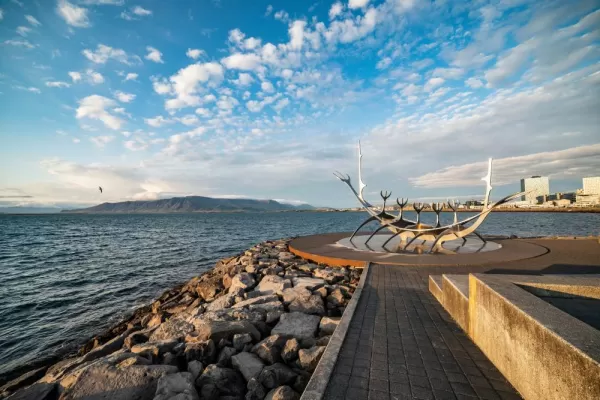Surtsey is a volcanic island in the North Atlantic, formed by a submarine eruption between 1963 and 1967 off the Westman Islands, south of Iceland. It is a UNESCO World Heritage Site. To protect its ecosystem, landing is prohibited, with access limited to scientists studying its plant and animal life. Mosses, fungi, and lichens were followed by vascular plants, along with about 300 invertebrate species and 90 bird species. Sailing around Surtsey offers views of the island’s rugged, volcanic contours.
Heimaey is situated off the southern coast of Iceland and is the largest of the Vestmann islands, and is the only inhabited island in the archipelago. The steep Edfell volcanoes and the green prairies of Herjolfsdalur offer a rich contrast of nature. On the Storhofdi road, look out over grey sand beaches and cliffs carved out by the Arctic Ocean. From here, you can also see the bronze landscapes of the mountaintops. You could visit Eldheimar, an ultra-modern and interactive museum which traces the volcanic eruption that Heimaey experienced in 1973.
Included Excursions:
Circumnavigation of Heimaey - 2 hours
Begin your tour from the harbor that for a long time has been a shelter for the Icelandic fishing fleet, but was almost lost in the volcanic eruption on the island in 1973.
After some 15 minutes of walking, embark on a boat to discover the island from the sea.
Sail past the cliffs surrounding the harbor to start an interesting and informative journey passing bird colonies with millions of inhabitants and exploring caves that can only be visited by boat.
The bird life you get a chance to see on this tour is magnificent, as the Westman Islands have one of the largest varieties of sea bird species in Iceland. These include puffin colonies of an estimated 6 to 8 million puffins. Nowhere else in the world can such large number of puffins be found in such close proximity to man.
In addition, the islands also house one of the world’s largest gannet and guillemot colonies. Numerous other species of nesting sea birds can also be seen. In addition to the bird life, whales are also often sighted, including orcas, dolphins, and porpoises.
After viewing the island and bird cliffs from every angle, the boat tour (approximately 1 ½ hours) ends by sailing into Klettshellir (Cliff Cave). From there, return to the harbor.
For this easy excursion, it is recommended you wear comfortable shoes, a windproof and waterproof jacket, and take a warm pullover. Please be aware that this tour is weather-dependent and that circumnavigation may not be possible. Wildlife sightings are not guaranteed. The sight of puffins can go down after mid-August.
Heimaey, Pompeii of the North - 3 hours
Leave from the perfectly formed natural harbor with its tall cliffs inhabited by multitudes of birds. Both the birds and their eggs have been an important source of food for the islanders. From there, drive from the pier into the Herjolfsdalur Valley, where ruins of old farmhouses dating back to the settlement can be found.
The tour then continues along the scenic western part of the island, providing an opportunity to view the outer islands of the archipelago. The youngest island, 'Surtsey', was formed in a volcanic eruption in 1963; it is a UNESCO World Heritage Site.
Next, a photostop will be made at Storhofdi, which offers magnificent views over the island; here, puffins nest during spring and the early summer months.
The tour continues to two volcanoes, the 5,000-year-old Helgafell, 'Holy Mountain', and the considerably younger Eldfell, 'Fire Mountain', which erupted in 1973, making it necessary to immediately evacuate the islanders to the mainland. Stop here and walk to the viewpoint for a panoramic view, about 10 minutes.
As you continue onwards, drive over the new lava field, making your way past the 'Skansinn' – a fort with a wooden church, which was donated to the people of the Westman Islands by the state of Norway to commemorate the millennium of Christianity in Iceland.
Then, visit the new Eldheimar – 'Pompeii of the North' Museum, where the history and aftermath of the 1973 eruption is explored. After the visit to the museum, you will head back to your ship.
It is recommended you wear good and comfortable walking shoes and dress in layers. The walk up the viewpoint is very steep and can be slippery.



























